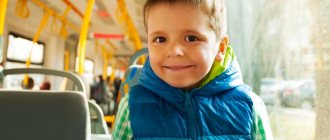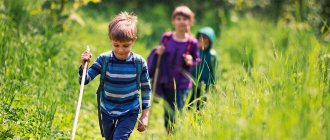Teaching children safety is not an easy task. But this needs to be done from a very young age. After all, a culture of safety is being formed for life. Of course, the most important thing in this case is the parents’ own example. Their safe behavior, compliance with the rules, care, support and protection.
First of all, parents are responsible for shaping the child’s correct views of the world and his safety. This starts from the first minute of birth. Together with organizing one’s behavior, proper feeding, and caring for the baby, an important problem arises - the safety of children in various life situations.
The world around us gradually captures the child's attention. Every day he tries to learn, try something new. Only the correct behavior of parents (or persons caring for children) ensures safe acquaintance with the alluring unknown of any subject.
In this case, the first task is to create the safest possible conditions in the child’s location. There is no need to wait for the moment when trouble might happen: you need to first think through every little detail in the child’s environment. Unfortunately, there are often unpleasant problems that require difficult, long-term treatment (for example, pouring boiling water from a kettle on yourself).
When a child is under 3 years old, the main role belongs to the mother. Concerns grow like a snowball when the skills of crawling and walking appear. Many common household items pose a danger to children: chairs, tables, sockets, dishes, small toys, household appliances and other elements. It is recommended for parents to explain their correct use and compliance with safety measures in the form of games, constant conversations, and communication with the baby. The learning processes must take place in parallel with an explanation of the safe use of toys and surrounding objects. At the same time, you need to talk to your child as much as possible. For him, his mother’s affectionate voice is the main source of his correct perception of the world.
In modern times, along with interesting devices and toys, a special problem has arisen for parents: interactive games, the Internet, a sea of different types of toys that attract even children under 3 years old. Surprisingly quickly they begin to understand them, demand them and play endlessly, which, undoubtedly, should be under the control of their parents and directed in the right direction. This problem becomes the main one as the child grows and also requires taking into account safety measures in order to preserve, for example, the children’s vision.
The time of children under 3 years old quickly ends, and each child enters a time of another life, which is associated with his adaptation to modern society with its laws and rules of safe behavior. Not only parents and relatives, but also kindergarten teachers and teachers help them master them. In this case, the first step is to know the last name, residential address, and telephone numbers of the parents. Through joint efforts, knowledge of safe rules of behavior is constantly checked, mistakes are sorted out, and small checks are carried out depending on the age of the child.
Children's safety at home
Even in a properly organized home environment, surprises can appear that pose a danger to children. For example, the ability to climb onto a windowsill or go out onto a dangerous balcony. We must try to anticipate the maximum number of dangerous situations and prevent their occurrence. To control them, it is suggested to use the list of “popular” dangerous places at home:
- Sockets, electrical appliances. They should not be accessible.
- The stove in the kitchen is considered a particularly attractive place. The kettle is hot, pots should not be placed close to the edges.
- All sharp corners on furniture must be protected with special pads.
- Bags (children like to put them on their heads), laces, ropes, belts, and scarves are often tried on around their necks.
- All chemicals poured into bottles resembling juice, water (vinegar, detergents).
- Cutting, piercing means. Needles, threads, manicure accessories, buttons, pins.
- Medicines, matches, lighters.
The time to leave children at home alone always comes in every family. This is determined individually and depends on independence and trust in the child. Gradually taming him to be alone must be done, providing the following safety techniques :
- In a visible, accessible place (always in the same place) leave the telephone numbers of: parents (work and personal), (closest relatives who can come quickly). Police, ambulance, neighbors. Children now have their own mobile phones early, and they use them well.
- Check the operation of the gas stove, water, close windows, doors or check safety devices. Leave food for children in cooked form or teach them to use a microwave heating device.
- Teach children to use the peephole and not to open the door at the first signal on the intercom or door. When a stranger appears at the door, never say that you are alone at home (it is also prohibited to do this on the phone), but quickly contact one of your parents’ phones, your neighbors (or call the police).
- Explain to children that they are safe behind a closed door. You are not allowed to go onto the site. We must wait for the departure of the stranger standing outside the door.
- When leaving home in the evening, you must leave the lights on in the rooms.
- If a child is allowed to go for a walk (age and training in the rules of walking allow it), then the keys to the apartment should not be placed on the neck or belt. To do this, you need to provide a convenient internal pocket with a clasp. Before a walk, a child should be taught to follow the following rule: leave information about where, with whom, for how long he is going, and when he will return home. Indicate a way to quickly contact him.
But what about the law?
- UN Convention on the Rights of the Child of November 20, 1989.
- FEDERAL LAW of December 29, 2012 N 273-FZ “ON EDUCATION IN THE RUSSIAN FEDERATION” (adopted by the State Duma of the Federal Assembly of the Russian Federation on December 21, 2012).
- SanPiN 2.4.1.3049-13 (for kindergartens) - replaced by SP 2.4.3648-20 “Sanitary and epidemiological requirements for organizations of education and training, recreation and health improvement of children and youth.”
- SanPiN 2.4.2.2821-10 (for general education institutions) - replaced by SP 2.4.3648-20 “Sanitary and epidemiological requirements for organizations of education and training, recreation and health improvement of children and youth .
These documents must be followed first.
Information security for children
Children learn practical skills for safe living during their formative years in different ways. Advice from parents such as “don’t go”, “don’t talk”, “don’t take”, etc. is not immediately followed correctly. The role of the particle “not” in the conceptual apparatus is not formed immediately. Often the opposite action follows: “do not open, is replaced by the meaning - open”, etc.
Psychologists advise presenting safety information in other terms with detailed clarification. For example, instead of the prohibition “don’t walk,” it would be more correct to say “walk in the yard, not far from the house.” Instead of the expression “don’t open”, say “don’t open the door quickly, without looking through the peephole, and to strangers.” It is better to submit prohibitory actions in a permitting format with explanations of what needs to be done.
Information security rules can be combined in the following areas:
1. Knowledge of complete information about the child’s friends, their places of residence, parents’ addresses (and do not be afraid to leave your coordinates). Places for games in your own and neighboring yard.
2. Explanation of life-threatening situations located in the gaming area. For example, rules of conduct on open water, correct activities on the water. To do this, the first skills must be explained while bathing in the bath (dive, hold your breath, do not close your eyes under water). The main thing is to overcome the first fear when children “lose the bottom” under their feet. Talk about the dangers of frozen bodies of water and walking on thin ice.
3.Training of traffic rules for pedestrians. At the same time, it is important to remember that children tend to imitate, and if parents themselves violate the requirements of crossing a green light or a zebra crossing, then the children will definitely try to do the same. The results may be severe. The optimal route must be mastered together, many times, fulfilling all the requirements, despite the behavior of those walking nearby.
It must be taken into account that a small child does not always hear the warning signals of a car. He fixes attention on several objects simultaneously. A child's emotions and temperament can be caused by surprise at a new car model or any other object. Joy and curiosity distract him from caution and elements of safety. At the same time, when walking with a teenager, you need to give him a certain amount of independence without causing excessive moralizing, which causes a negative reaction.
4. In addition to instructions, parents should always remember to behave tactfully with children, especially when explaining safety information. This refers to talking about sexual problems that arise in unfavorable situations. From early childhood, it is recommended to carefully explain to children which places should not be allowed to be touched by strangers.
Why can’t you visit a public toilet alone, walk in vacant lots, go into basements, abandoned buildings. Unfortunately, sexual crime in the present world has increased greatly and children need to know about it. Children should not take candy or other sweets from strangers, approach unknown cars, or respond to offers like “I’ll take you to mommy.”
5. Particular attention should be paid to the issue of communication with animals on the street. It is best if you have your own dog or cat at home, and parents regularly talk about different breeds of dogs, their character, and rules of behavior when meeting.
6.An innovation in the modern world is communication on the Internet. This type of progress (useful and interesting) cannot be stopped. But it is fraught with many dangers for an unformed child’s worldview. To avoid very unpleasant situations, it is recommended to follow these rules when purchasing a computer for the first time:
- stipulate a list of rules for visiting the Internet. The computer must be within sight of parents. Have anti-virus programs, settings, filters used for safe travel on the Internet. Set the “parental control” mode with a list of prohibited sites, games, and programs. Negotiate working hours online;
- constantly talk with children about their friends on the Internet. Explain why you can't meet them (they're often not who they say they are online). Learn to use a pseudonym (during online games) without giving away personal information. Do not open files or messages from unfamiliar recipients;
- Problems of gambling, sites with pornography, and violence should be discussed with teenagers. You can’t simply prohibit doing this (the forbidden fruit is sweet). Only trusting, friendly relationships help to cope with unwanted information and develop the right attitude towards all information from the Internet. And then you don’t have to listen to the famous expression “the Internet is a garbage dump”, but get a lot of interesting knowledge without going to the library.
Child development center – kindergarten “Smile”
Comprehensive security of an educational institution
* this is the state of protection of an educational institution from real and foreseeable threats of social, man-made, natural and other characteristic types, which ensures its sustainable functioning.
Integrated Security Management
* This is the activity of an institution
to ensure public safety, environmental safety, personal safety, and other types of safety provided for by the legislation of the Russian Federation .
* PURPOSE: ensuring the safety of life and health of participants in the educational process in our institution.
Security areas
Choose a section:
| Anti-terrorism security | A number of anti-terrorism in the kindergarten : a daily inspection of the preschool institution and the surrounding area is carried out for their security: detection of foreign objects, checking the functionality of the alarm button, landline telephone communication |
| Road safety Safety when transporting children | Teaching junior and senior preschoolers in kindergartens the rules of the road (traffic rules) and preventing child injuries on the roads is an obligatory part of the educational process in preschool educational institutions. The requirements specified in the educational program for teaching children the road alphabet should become more complex depending on the age of the children. |
| civil defense | Civil defense of a preschool educational institution is a system of defense measures carried out in peacetime and wartime in order to protect preschool employees, technical personnel and students from weapons of mass destruction and other means of enemy attack, as well as from the consequences of accidents, catastrophes and natural disasters. |
| Student health protection | The main task of the teaching staff of the kindergarten is to create conditions for preserving and strengthening the health of children. In preschool educational institutions, great efforts are made to organize health-improving work: a system of health-improving work has been developed taking into account the conditions of the preschool educational institution and the contingent of children, including medical diagnostics, hardening, physical education and recreational work, rational nutrition, etc. |
| Emergency Safety | Emergency prevention is a set of measures carried out in advance and aimed at minimizing the risk of emergency situations as much as possible, as well as preserving people’s health, reducing the amount of damage to the environment and material losses in the event of their occurrence. Federal Law of the Russian Federation dated December 21, 1994 No. 68-FZ “On the protection of the population and territories from natural and man-made emergencies” |
| Environmental Safety | Environmental safety system — a system of measures that ensure, with a given probability, the permissible negative impact of natural and anthropogenic environmental hazards on the environment and the person himself |
| Information Security | Information security is the practice of preventing unauthorized access, use, disclosure, corruption, alteration, examination, recording or destruction of information. This universal concept applies regardless of the form the data may take (electronic or physical, for example). The main objective of information security is the balanced protection of confidentiality, integrity and availability of data, taking into account the expediency of application and without any damage to the productivity of the organization. |
| Occupational Safety and Health | The main principle securitylaborVpreschooleducationalinstitution is to create and ensure healthy and safe working conditions, prevent accidents and occupational injuries to employees of the institution. |
| Fire safety | Fire departmentsafetypreschool educational institution . The state of protection of children and employees, property, buildings and structures from fires and other dangerous situations. 2. Fireproof mode preschool educational institution . Set of requirements fire departmentsecurity , defining the rules of behavior of people, the order of organization of work preschool educational institution and maintenance of adjacent territories, buildings and premises, and other protection objects. |
| Protection of children's rights | Protecting the rights of the child is one of the most important tasks of the state. State policy is based on ensuring the unity of rights and obligations, the responsibility of officials and citizens for violating the rights and legitimate interests of a minor, causing harm to him, and creates conditions for the protection and defense of these rights. |
Child safety at the entrance
For a child walking in the yard, the sight of his own entrance door seems like a reliable shelter, protection in any ambiguous situation. They always run to her, hoping to find salvation behind a familiar door. Sometimes the protective functions are greatly exaggerated and there, inside your own entrance, a misfortune can happen. Parents should teach children of any age the correct behavior in the entrance.
Caution and attention must be observed when approaching the house and at the following stages:
1.When approaching the entrance, it is recommended to pay attention to the people walking nearby and make sure that none of them are showing increased attention or surveillance. At the same time, the person looks like an ordinary passerby. In this case, you need to call your parents, wait for neighbors and acquaintances to appear, and enter the entrance together with them. Parents should explain to their children the operation of the entrance door closing mechanism using a special closer. The door closes with a time delay and the child must close the door himself and wait for the clap. Even a small gap cannot be left;
2. It is prohibited to enter the entrance immediately behind a person who has caused suspicion, discomfort, or simply a stranger. He can wait for the child outside the entrance door, on the stairs, or in any other place. If a stranger is standing at the entrance, then for safety the child must be explained that it is not shameful to ask for help in the passage to the apartment together with a familiar person (neighbors, older brothers, men with a child, police officers).
3. If a suspicious stranger appears at the entrance together with an excited child. Children should know that they must ring any door on the first floor (you can call all of them at once), explain the reason for the concern and ask to be escorted home. It is strictly forbidden to talk to a stranger or answer his questions. Even if he offers to “save the kitten,” “give me help,” “I’ll take you home to mom, she asked.” The child has the right to completely ignore the conversation.
4.Using an elevator requires special care, skills, and unquestioning compliance with safety requirements:
- children can travel independently on the elevator after training and repeated checking of the rules of use;
- While waiting for the elevator, the child should carefully monitor persons approaching him. It is recommended to turn to face them and prepare for a surprise attack. It is strictly prohibited to enter the elevator cabin together with strangers. If you are in it with a stranger, the child should face him and next to the door. In difficult situations, when unwanted actions occur (touching clothes, attempts at violence), it is necessary to remain calm, try to defend yourself (hit in the groin, bite the nose, lip), press the button for the nearest floor to stop and run screaming. It's good to have a can of aerosol (even mosquito repellent) and point it at a stranger's face;
- After exiting the elevator, you should carefully look around and not open the door with the key if there are strangers nearby. Otherwise, you need to press the buttons of all your neighbors, ask for help and enter home in their presence.
Topic: “Safety, protection and health of children in kindergarten.” - presentation
Topic: “Safety, protection and health of children in kindergarten.”
Goal: to familiarize employees of preschool age 17 with safety instructions, protection and preservation of the health of children in kindergarten.
What should a teacher know and do when teaching? safety instructions; fire safety rules; know how to use a fire extinguisher; instructions for providing first aid to victims.
Dangerous and harmful factors from which the teacher must protect children. incorrect selection of children's furniture. insufficient lighting. faulty electrical equipment. improper storage and use of piercing, cutting small objects. improper storage and use of medicines and disinfectants.
Requirements for equipping kindergarten premises. all opening windows must open inward; doors should not be closed using springs; Room thermometers and a first aid kit should be posted; work equipment should be located in cabinets and on shelves; It is prohibited to drive nails at the height of children; Broad-leaved flowers should not be placed on the windowsills of kindergarten premises.
Rules for handling scissors. Children are allowed to use scissors only under the guidance of a teacher; scissors for pupils to work independently must have rounded ends; scissors, as well as any piercing, cutting objects that are dangerous to the life and health of pupils, medicines, as well as disinfectants must be kept out of the reach of children; Children are given serviceable and safe objects with well-secured handles for use.
Safety requirements during various types of teaching activities. Seat students at tables in accordance with height indicators. Assign seats to students with significant hearing loss - at the first and second tables. with reduced visual acuity - near the windows behind the first tables, the light should fall from the left side; prone to frequent illnesses, acute inflammation of the upper respiratory tract, rheumatic diseases - away from the window. Do not cross-ventilate the premises during breaks between classes. The duration of viewing filmstrips should be no more than 15 minutes. The TV should be installed at a height of 1–1.3 m from the floor. The duration of watching TV shows should be 20 minutes for children four to five years old, up to 30 minutes for children six years old.
. Requirements for catering: food must be served from the kitchen at a time when there are no children in the corridors and stairs; while serving food, do not allow children to play near the dining tables; It is prohibited to bring boiling water into group rooms; the temperature of hot food when served should not exceed 70 °C; During meals, it is necessary to ensure that students use cutlery correctly; to avoid injury, tableware and teaware should not have cracks or chips; It is prohibited to bring food from home to the kindergarten to treat children.
Safety requirements in emergency situations. If a fire occurs, it is necessary to: immediately evacuate the students (according to the evacuation plan) from the premises, closing all the vents and windows (in order to prevent the spread of rapid fire). report the fire to the manager. call the fire department. if necessary and possible, turn off the electricity; begin to extinguish the fire using primary fire extinguishing agents. If necessary, notify emergency services. If a child is injured, it is necessary to: immediately provide first aid to the victim. Maintain the injured child's vital functions until a medical professional arrives. inform the administration of the institution, the head nurse, and parents about this.
Basic rules of the teacher. If a student is not feeling well or is injured, the teacher must immediately notify the head nurse, the head of the preschool educational institution and the child’s parents. It is necessary to provide at least two hours of restful daytime sleep for pupils. When children sleep, the presence of a teacher (or his assistant) in the bedroom is mandatory. Children's shoes and clothes should be comfortable for games and activities. Shoes should have non-slip soles, a small heel, a heel, and fit tightly on the foot. In the evening, the teacher is obliged to hand over the child to the mother or another person who comes for him. It is prohibited to give children to: persons under 16 years of age. persons in a drunken state or with inappropriate behavior.
Children's safety on the street
Walking in the fresh air begins for children from early childhood. At this time, parents have a unique opportunity to teach their children the rules of safe play outside. At the same time, we must not forget about the parents’ own behavior (for example, do not drag a sled with a child across the road, constantly talk on a mobile phone, not paying attention to the actions of the children). The child quickly grows out of the safety of strollers, begins to walk, strives to go anywhere, to gain “freedom.”
From this time on, long lessons begin in teaching the main techniques of safe behavior:
- Explain where the roadway is for cars and where pedestrians should be. Children need to be told that a car cannot stop quickly; there is a braking distance. It is prohibited to run out onto the roadway, even if your favorite ball has rolled there.
- You cannot touch a car (even a standing one), hide behind its wheels while playing hide and seek, or run up to a slowly moving car (even when mom or dad is driving).
- Calmly step aside to the entrance and wait for the car to pass in the yard.
- Walk around a standing car from the front, from behind at a certain distance (if it moves unexpectedly, there is time to jump to the side).
Emphasis is placed on teaching proper street crossing techniques. All adults nearby should participate in this process together with parents.
- You must cross the road only in places where crossing is permitted (zebra crossing or traffic light).
- It is strictly forbidden to run on crossings: you must walk at a calm pace. If there is any uncertainty, you should wait for an adult and go with him. There is no need to rush to the permission signal: behind the first moving car there may be another one that is finishing its movement. You should skip it.
- Do not violate the basic rule of crossing the road: first look to the left, in the second half of the crossing - to the right.
- If there is an underground passage, you should use it first.
- It is not safe to bypass public transport (tram, bus, trolleybus, minibuses) from any direction. Parents should pay special attention to this point. You should wait for public transport at stops (not on the nearest roadsides).
- When crossing roads with insufficient visibility (evening, night, snow, rain, fog), be sure to have reflective fabric inserts on your clothing. Special flickers: badges, tags, bandages, visible in the dark. They are visible to drivers at a distance of 180 m in the light of low beam headlights and up to 400 m when illuminated by high beam headlights.
- When hiking in organized groups, special rules are followed. They provide for movement in a column, accompanied by an adult and a special person at the end of the formation. Children have any identification marks (flags, balls, flowers).
- If a child rides a bicycle or rollerblades, then the parents will explain to him the rules for crossing the road. The process is carried out together several times. When you need to stop, get off the bike, pick up the rollers, they explain until you fully understand and confidently act.
When visiting places of public events, celebrations, trips to markets, shops or other places where there will definitely be a lot of people, it is necessary to ensure the following safety elements:
- For young children, choose clothes with a label (name, surname, telephone number, contraindications for medications). It is advisable to have a bright outfit that is clearly visible from a distance.
- Bring a clear photograph of your child with you.
- A small child should always be held by the hand (and not by the parents’ bag or clothes). He must stand in front of an adult while choosing a product.
- The time and place of meeting are agreed upon with teenagers in advance.
Children's safety in transport
Nowadays it is difficult to imagine a young family living in the city without a personal car. It has long become a necessity, and not an element of “show off” of a luxurious life (although there is such a thing). From early childhood, important children travel with mom and dad in private transport out of town, to the clinic, to the store. Parents are required to ensure their safety by following the approved travel rules and their own precautions (for example, not driving during rush hours or on dangerous sections of the road). To ensure safe travel with children, it is recommended to follow these rules:
- Children under 12 years of age must travel in special seats designed for the weight and height of the child.
- Children under 12 years of age are allowed to sit in the front seat if there is a child restraint system.
- All passengers of personal transport must wear seat belts (regardless of the duration of the trip).
- The safest seats in the cabin are in the middle and on the right, when it is easy to get out onto the sidewalk.
As the child grows and matures, he will have to be able to use public transport. At the same time, from childhood he should know that he must carefully wait for the transport to come to a complete stop and not go out onto the roadway. And only after that begin boarding without jumping into the departing vehicle:
- Enter from the sidewalk through the back platform (exit through the front).
- Let older passengers pass and give them a seat.
- During the trip, if there are no seats, you must use the handrails and not interfere with the passage of other passengers. Take off the huge backpack and hold it in your hands while moving.
- When exiting public transport, you must stop on the sidewalk (to the side, not in front of the exit and disturb the next exiting) and determine the location of the nearest crossing (if required). You cannot pass around the vehicle. We must wait for his departure and continue moving along the required route according to all the rules. At this time, the child becomes a “pedestrian”. He must be able to assess the traffic situation in all directions: what the nearest car is doing: standing still, continuing to move. What operating mode is the traffic light in? If at least one condition corresponds to the “prohibited” value, you need to understand that it is dangerous and wait for the road situation to change.
- It is prohibited to distract the driver, open doors on your own, lean out of open windows, or throw garbage through them.
Instructions on the rules of safe behavior for pupils of a preschool educational institution (kindergarten)
Kindergarten teachers need to study with their students instructions on the rules of safe behavior for preschool children in everyday life, public transport, when finding unfamiliar and dangerous objects, when communicating with strangers, on the street and in public places. Also, it is very important to explain to students the rules of behavior on water, on ice, with fire, during a thunderstorm and in the forest.
download: Documentation on Fire Safety in Preschool Educational Institutions 38 documents taking into account laws as of September 8, 2022!
32. Instructions on the safety rules for children at home (at home and in the yard) 33. Instructions on the rules for the safe behavior of children on the road 34. Instructions on the safety rules for children in public transport 35. Instructions on the safety rules for children at railway transport facilities 36. Instructions on rules for the safety of pupils at water transport facilities 37. Instructions for the safety rules for pupils when explosive objects and substances are detected 38. Instructions for the safety rules for pupils with strangers (in situations of violent behavior by adults) 39. Instructions for the prevention of criminal situations in the yard, on the street, at home and in public places 40. Instructions for the prevention of negative situations in public places 41. Instructions for the safety rules for students on ice 42. Instructions for the safety rules for students on the water 43. Instructions for the safety rules for students during thunderstorms and lightning 44. Instructions for the rules safety rules for pupils with fire 45. Instructions for the safety rules for pupils with animals and insects 46. Instructions for the safety rules for pupils with plants and mushrooms 47. Instructions for the safety rules for pupils when taking walks on the site 48. Instructions for the safety rules for pupils when taking walks in icy conditions 49. Instructions on the rules of safe behavior of children when conducting excursions, targeted walks with exit from the territory
download: Instructions for the catering unit (kitchen) Instructions for the catering unit of the School, preschool educational institution, Canteen, Restaurant, Cafe. Update: 09/05/2021
Child safety in kindergarten
Attending kindergarten is the first step in the life of children, when there is a need for responsibility, discipline, and attentive communication not only with parents, but also with the teacher and nanny.
This is a very important period for parents, not only in terms of child development, but also in promoting safe behavior. From the first steps you need to talk to the baby, explaining to him any situation.
The safety of a child’s stay in a preschool institution is ensured by its employees, who strictly comply with the requirements of all current rules and instructions. Together with parents, they help children develop safe communication techniques and adaptation to living conditions in society. An extensive list of rules for safe stay in the garden has been approved. It includes the following elements:
- A system of access to the territory, “handing over” the child to the appropriate group. Parents should not send their children alone, taking them only to the gate. Notification of the teacher and nanny about arrival is done daily. It is not allowed to leave a child in someone else's group, together with a watchman or watchman. Information about the morning time of arrival at the garden; breakfast is provided upon arrival.
- Full information about who brings and has the right to pick up the child is clarified upon admission in the prescribed manner. Parents must explain to their children that it is forbidden to leave the kindergarten with anyone (except legal representatives). The kindergarten service stores documents in the form of copies of passports of legal representatives, issued powers of attorney for persons who are allowed to give the child. Sometimes a special pass is issued. Children cannot be given to strangers under 18 years of age.
- Parents, together with teachers, must explain to their children the rules of games on playgrounds. In sports halls, music halls, and specific group rooms. Teach the rules of storing clothes and the skills of dressing independently.
- The safety of children is ensured by the implementation of approved fire and electrical safety measures. For this purpose, educational seminars and trainings are regularly held. Each garden has security doors, a panic button, a child evacuation plan, and fire protection equipment. Medical office, special worker to provide first aid until the ambulance arrives. The entire process of familiarization with safe methods is aimed at teaching, protecting, and anticipating any unfavorable situation. From an early age, create a culture of safety for the future adult.
Instructions on safety rules for preschool children
Conducting briefings on the presented instructions on the rules of safe behavior and safety precautions for pupils of a preschool educational institution (kindergarten) is mandatory for teachers of a preschool educational institution.
download: Regulations for preschool educational institutions 84 regulations in a package or individually. Update date: 10/06/2021
1. Instructions on safety rules in preschool educational institutions (introductory briefing) 2. Instructions on safety rules for children in the context of a new coronavirus infection 3. Instructions on safety rules in the playroom 4. Instructions on safety rules in the bedroom 5. Instructions on safety rules in the music room 6. Instructions on safety rules in the speech therapist's office 7. Instructions on safety rules in the speech therapist's office 8. Instructions on safety rules in the medical office 9. Instructions on safety rules when eating food 10. Instructions on safety rules in the washroom and toilet room 11. Instructions on the safety rules for children when brushing their teeth 12. Instructions on the safety rules when dressing in the locker room 13. Instructions on the safety rules when handling the door 14. Instructions on the safety rules when going up and down flights of stairs 15. Instructions on the safety rules when working with plasticine , clay 16. Instructions on safety rules when playing and experimenting with sand and water 17. Instructions on safety rules when working with pen, pencil and felt-tip pen 18. Instructions on safety rules when working with brushes and paints 19. Instructions on safety rules when working with a needle 20. Instructions on safety rules when working with scissors 21. Instructions on safety rules when working with glue 22. Instructions on safety rules when working with material for the development of fine motor skills 23. Instructions on safety rules when working in a corner of wildlife 24. Instructions on safety rules when working in the garden 25. Instructions on safety rules when conducting physical education classes 26. Instructions on safety rules when conducting gymnastics classes 27. Instructions on safety rules when conducting athletics classes 28. Instructions on safety rules when conducting classes on sports and outdoor games 29. Instructions on safety rules during sports competitions 30. Instructions on safety rules during classes using electronic learning tools (ESL) 31. Instructions on safety rules when using gaming equipment and equipment
download: Job descriptions for preschool educational institutions (Profstandard) 31 instructions individually and in packages, updated - September 5, 2021!
The presented safety instructions will protect preschool children from possible injuries both in the kindergarten and on its territory, and on the street, and at home, will prevent accidents, and will protect their health.
Children's safety at school
Nowadays, the school has become different in many ways. It is here that children not only study according to approved programs for many subjects, but also receive their first “bruises” from modern life. Difficulties that arise in front of them are often solved independently (and in different and not entirely correct ways). Correct behavior depends on the degree of preparation, knowledge of information related to different situations, which parents must first of all give tactfully and discreetly.
School problems that create an unsafe existence for 10 years can be represented by the following list:
- The period of elementary school with kids has its own characteristics. They consist of organizing mandatory accompaniment of children and picking them up from school. The child should know that he should not use a stranger’s invitations to take him home or accept a gift. Going alone to unfamiliar places. Tell your teacher, security guard, or call your parents about any difficult moments.
- More safety problems arise when children start going home and going to school on their own. It’s good to remember the words of the famous song: “If you go on a journey with a friend, the road is more fun,” and not only more fun, but also safer. This is one of the main rules: try not to be alone, inform your parents in time about your route of movement.
- You cannot linger alone to play in parks, squares, and ravines.
- Despite enhanced school security measures, situations arise when a stranger enters the school. If children see him in the toilet, they should know to leave immediately. Inform the watchman, teacher. There is a separate toilet for adults.
- Adult schoolchildren need to be told in detail about the “new” modern dangers: the use of drugs, participation in terrorist acts, theft of children (especially girls), sexual perversions, and careful attention to working on the Internet.
- At any age, children must report the place and time of classes in sports and other sections. Introduce parents to the coach, clarify the working hours, get the maximum number of telephone numbers (coach, friends). The route for the child's return must be agreed upon and known to the parents.
- In any attempt to attack a child (he may be pushed into a car), he must be able to defend himself: scream loudly, attracting others. Apply the rules of self-defense (they must be shown at home, in sections).
- Nowadays situations often arise with evil ridicule, teasing, and conflicts with classmates. During confidential communication, an adult should not fiercely rush to protect his child, but he should not remain silent either. We need to go to school, figure it out, involve the parents of the other side, the class teacher, and resolve the conflict peacefully. But you shouldn’t do this often: the child will be able to solve his problems himself, using advice after a friendly conversation at home. Such cases are inevitable for smart, well-mannered children. They need help.








